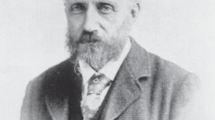Abstract
A numerical and experimental investigation of steady incompressible developing turbulent flow in smooth pipes is presented. Finite difference techniques are used to solve simultaneously the vorticity transport and stream function equations utilising a modified form of the Van Driest effective viscosity model. The numerical solutions are verified experimentally using air as a working fluid at pipe Reynolds 1 × 105, 2 × 105 and 3 × 105.
Similar content being viewed by others
Abbreviations
- a :
-
coefficient in (9)
- b :
-
coefficient in (9)
- c :
-
coefficient in (9)
- d :
-
coefficient in (9)
- D :
-
pipe diameter
- f:
-
known constant or function (23)
- K:
-
mixing length constant (Value=26)
- L :
-
limiting length for fully developed flow
- M :
-
number of iterations (24) and (25)
- p :
-
static pressure
- p s :
-
wall static pressure
- r :
-
radial coordinate
- R :
-
pipe radius
- Re :
-
pipe Reynolds number (U D/ν)
- S :
-
defined by (5)
- u :
-
axial mean velocity
- u′ :
-
fluctuating component of axial velocity
- U :
-
bulk or average velocity
- U c :
-
centre line velocity
- U cf :
-
centre line velocity in fully developed flow
- u ⋆ :
-
local friction velocity
- v :
-
radial velocity
- v′ :
-
fluctuating component of radial velocity
- x :
-
axial coordinate
- y :
-
distance from wall along a radial line
- y + :
-
dimensionless distance (y +=yu⋆/ν)
- α :
-
under-relaxation parameter
- γ :
-
effective viscosity
- ε :
-
eddy viscosity
- λ :
-
convergence criterion
- ν :
-
kinematic viscosity
- ξ :
-
damping constant (Value=0.41)
- ρ :
-
fluid density
- φ :
-
variable in general elliptic equation
- ψ :
-
stream function
- ψ s :
-
stream function at the wall
- ψ 1 :
-
constant of integration
- ω :
-
mean vorticity
- ω s :
-
mean vorticity at the wall
References
Laufer, J., NACA Rept. 1174 (1954).
Lawn, C. J., J. Fluid Mech. 48 (1971) 477.
Holdhusen, J. S., Ph.d Thesis, University of Minnesota, 1953.
Barbin, A. R., Ph.d. Thesis, Purdue University, 1965.
Mizushina, T., L. Ryuso, U. Hiromasa, T. Shigeka, and H. Hideo, J. Chem. Eng., Japan 3 (1970) 34.
Brighton, D. A. and J. A. Bowlus, Trans. ASME 90 (1968) 431.
Bradley, C. I. and D. J. Cockrell, Proc. Heat Trans. and Fluid Mech. Inst., Stanford University Press, 1970.
Comte Bellot, G., Pub. Sci. et Tech. due Ministere de l'Air, No. 419 (1965).
van Driest, E. R., Trans. ASME 78 (1956) 915.
Gosman, A. D., W. M. Pun, A. K. Runchal, D. B. Spalding, and M. Wolfshstein, Heat and Mass Trans. in Recirculating Flows, Academic Press, 1969.
Hirst, D. E. and E. A. Coles, Computation of Turbulent Boundary Layers, 2. Stanford University Press, 1968.
Author information
Authors and Affiliations
Rights and permissions
About this article
Cite this article
Richman, J.W., Azad, R.S. Developing turbulent flow in smooth pipes. Appl. Sci. Res. 28, 419–441 (1973). https://doi.org/10.1007/BF00413081
Received:
Revised:
Issue Date:
DOI: https://doi.org/10.1007/BF00413081



